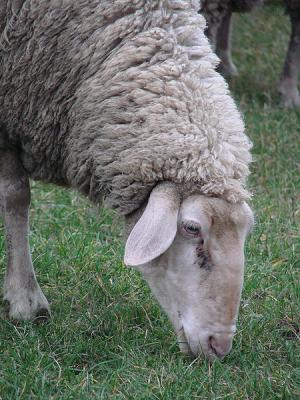Credits: Biovision-Infonet

(c) Steven Walling, wikipedia.org

(c) Gerals Wiener 1994 Animal breeding – The Tropical Agriculturalist. Macmillan Publishers
Sheep respond very well to good care and management, so the first step to improve their health is to provide good feeding and control diseases and parasites.
Introduction
Origin and history of sheep
The domestic sheep (Ovis aries) refers to selective grazing animals that may be domesticated (tamed) or wild. At one time all wild. Around 10,000 BC sheep were domesticated by humans. Most of the wool breeds of sheep were developed from Moulfan sheep . Most of the hair breeds are similar to the Urial sheep of ancient times. Prior to domesticating sheep, only the dog and reindeer were domesticated. As the animals were raised under tamed conditions, they went through several changes. On the outside the sheep began to develop more wool and less hair. The color of the wool and hair changed from brown and shades of brown to whites and blacks. Their ears became more of a lop ear than an erect ear. The horns that the wild sheep possessed were weakened and disappeared from many breeds. On the inside the sheep changed as well. These internal changes happened at both ends. The tails had less vertebrates or bones than the sheep do now. Today’s sheep also have a smaller brain than the sheep 12,000 years ago. Sheep were tamed for several uses that still apply today. The sheep were first used for mutton, skins, milk and wool. Sheep are still used for these basic purposes plus many more. Sheep by-products are in many items that we use every day.
Understand sheep as the animals they are
Sheep are ruminants with a four-chambered stomach, and as such, they spend about a third of their life ruminating and need peace and quiet. They are only plant eaters, and they are hunted by predators, where their main defense it to flock together in large numbers and to run away from predators. They become very scared and anxious when separated from their mates. This is also the reason for lambs being able to run and follow the flock few hours after birth. They have good senses: can scan their surroundings with few movements of their head and do this even when grazing, and they can locate a sound very precisely. In domesticated flocks, their fear of predators is used when using dogs to move sheep around. Sheep will consider the dog as a predator, flock together for protection and move away from the danger. Sheep have a flight zone, which is the space they like to keep between themselves and others, and it depends on the situation and on the tameness or wildness of the sheep. Sheep don’t like to walk in water or move through narrow openings. They prefer to move into the wind and uphill than down wind and downhill. Sheep are also very selective in their grazing habits, and their smell is important for them. Sheep have a split in their upper lip, with which they are able to pick the preferred leaves off of the plant.
In temperate zones, sheep are seasonal breeders. An ewe usually give birth once a year and have 1-3 lambs. They normally live to be about 8 years old, but can sometimes live to be as old as 20. Pregnancy lasts for 147 days. Lambs form strong bonds with their mothers, and mothers are very protective. The lambs can identify their mother by her bleat. Sheep are robust animals with a very good ability to adjust to the conditions. If they are diseased, they keep on moving with the flock to a point where they are almost dead, which just illustrates how dependent and connected they are to the flock, as the only defense against predators.